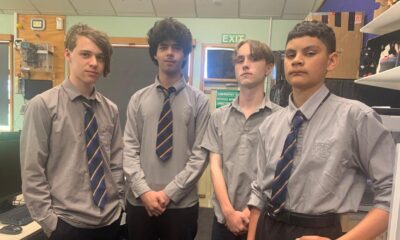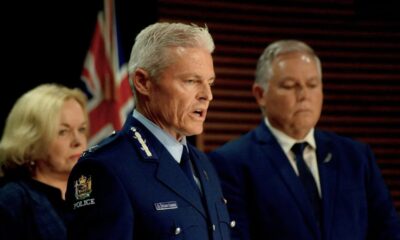Science
Unlocking Quantum Entanglement: A Key to Future Technologies

The rise of quantum technologies is prompting significant investment from governments and tech companies worldwide, with New Zealand recently announcing the establishment of the Institute for Advanced Technology. This initiative aims to explore the complexities of quantum mechanics, which underpins many modern advancements, including transistors, microchips, and lasers. As these technologies evolve, enhancing quantum literacy becomes crucial for informed discussions and policy-making regarding their societal implications.
Quantum mechanics is a fundamental theory that explains the structure of matter. The term “quantum” was introduced by German physicist Max Planck, who suggested that energy exists in discrete units known as quanta. This principle allows for the development of super-fast computers, precision sensors, and advanced encryption methods, all reliant on the peculiar properties of quantum systems. Central to these technologies is the phenomenon of quantum entanglement, which physicist Albert Einstein famously described as “spooky action at a distance.”
While quantum concepts sometimes find their way into popular culture—often with misinterpretations—entanglement remains a topic of fascination and confusion. For instance, in the science fiction novel Three Body Problem by Liu Cixin, entangled particles are depicted as a means for faster-than-light communication, a concept that defies established scientific laws.
Despite its fantastical portrayals, quantum entanglement has real-world applications. It enhances sensor technology, improving capabilities in fields such as medicine and environmental monitoring. Furthermore, quantum computers have the potential to tackle problems that are currently unsolvable by classical computers, such as understanding protein folding. Quantum cryptography offers robust encryption methods, ensuring secure communication while also providing tools for earthquake detection.
Understanding Quantum Mechanics and Entanglement
In classical computing, information is stored in bits, each representing a state of either 0 or 1. Quantum computers utilize qubits, which can exist in a state of superposition—representing both 0 and 1 simultaneously until measured. This characteristic allows for complex computations at unprecedented speeds.
To illustrate entanglement, consider two quantum engineers, Alice and Bob, each possessing a qubit from an entangled pair. Upon measuring their qubits, both will obtain either a 0 or a 1 with equal probability. However, a remarkable correlation emerges: whenever Alice measures a 0, Bob will also measure a 0, and the same applies for 1s. This phenomenon occurs despite neither qubit having a determined state until observed, suggesting a deep connection between the two particles that transcends spatial separation.
This non-intuitive behavior troubled Einstein, who believed that quantum mechanics could not be complete without hidden variables determining outcomes before measurement. Yet, experiments conducted in the 1980s have dismissed such theories, earning three physicists the Nobel Prize in 2022 for their work that confirmed the validity of quantum mechanics.
New Zealand’s Role in Quantum Research
While previous discussions focused on pairs of qubits, entanglement can be observed in various physical systems. Researchers in New Zealand are contributing significantly to this field. For example, superconductors, which exhibit zero electrical resistance when cooled below a certain temperature, rely on pairs of entangled electrons known as Cooper pairs.
A recent investigation led by a team involving Michele Governale proposed a method to extract entangled electron pairs from superconductors and transfer their entanglement to photons, the fundamental units of light. Another group successfully achieved entanglement between two atoms cooled to near absolute zero, showcasing the diverse applications of quantum principles.
To capitalize on these advancements, New Zealand must invest in fostering a quantum-ready workforce. This includes promoting quantum literacy at all educational levels, ensuring that society is prepared to engage with and benefit from these transformative technologies. As the global quantum effort expands, active participation and understanding will be essential for driving innovation and addressing future challenges.
“Not only must we actively contribute to and capitalise on the global quantum effort, we also have to lift quantum literacy at all levels of society – starting in school,” said Ulrich Zuelicke, emphasizing the need for targeted investment in education.
As quantum technologies continue to develop, the implications for industries and society at large are profound. Understanding quantum entanglement and its applications will be critical as we navigate this exciting frontier.
-

 World1 week ago
World1 week agoPrivate Funeral Held for Dean Field and His Three Children
-

 Top Stories2 weeks ago
Top Stories2 weeks agoFuneral Planned for Field Siblings After Tragic House Fire
-

 Sports3 months ago
Sports3 months agoNetball New Zealand Stands Down Dame Noeline Taurua for Series
-

 Entertainment3 months ago
Entertainment3 months agoTributes Pour In for Lachlan Rofe, Reality Star, Dead at 47
-

 Entertainment2 months ago
Entertainment2 months agoNew ‘Maverick’ Chaser Joins Beat the Chasers Season Finale
-

 Sports3 months ago
Sports3 months agoSilver Ferns Legend Laura Langman Criticizes Team’s Attitude
-

 Sports1 month ago
Sports1 month agoEli Katoa Rushed to Hospital After Sideline Incident During Match
-

 World2 weeks ago
World2 weeks agoInvestigation Underway in Tragic Sanson House Fire Involving Family
-

 Politics2 months ago
Politics2 months agoNetball NZ Calls for Respect Amid Dame Taurua’s Standoff
-

 Top Stories2 weeks ago
Top Stories2 weeks agoShock and Grief Follow Tragic Family Deaths in New Zealand
-

 Entertainment3 months ago
Entertainment3 months agoKhloe Kardashian Embraces Innovative Stem Cell Therapy in Mexico
-

 World4 months ago
World4 months agoPolice Arrest Multiple Individuals During Funeral for Zain Taikato-Fox


















